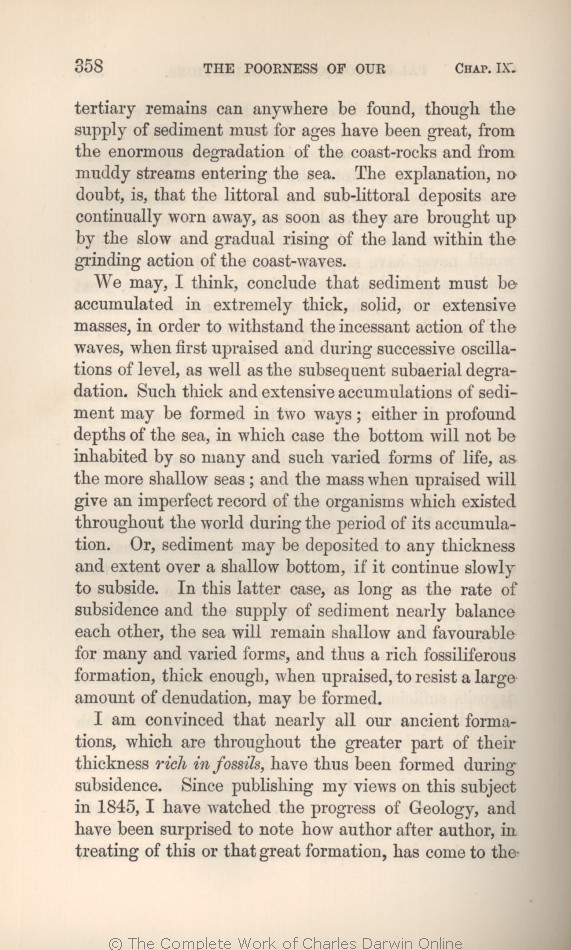|
tertiary remains can anywhere be found, though the supply of sediment must for ages have been great, from the enormous degradation of the coast-rocks and from muddy streams entering the sea. The explanation, no doubt, is, that the littoral and sub-littoral deposits are continually worn away, as soon as they are brought up by the slow and gradual rising of the land within the grinding action of the coast-waves. |
We may, I think,
..| ..... 1869 1872 | | safely 1859 1860 1861 1866 |
| successive 1869 1872 | | subsequent 1859 1860 1861 1866 |
| level, as well as the subsequent subaerial degradation. 1869 1872 |
| level. 1859 1860 1861 1866 |
| either 1861 1866 1869 1872 | | either, 1859 1860 |
| case 1869 1872 | | case, 1859 1860 1861 1866 |
| OMIT 1869 1872 |
| judging from the researches of E. Forbes , we may conclude that 1859 1860 1861 |
| judging from the rescarches of E. Forbes , we may conclude that 1866 |
| not be 1869 1872 | | be 1859 1860 1861 1866 |
| so many and such varied forms of life, as the more shallow seas; 1869 1872 |
| extremely few animals, 1859 1860 |
| few animals, 1861 1866 |
| and the mass when upraised will give an imperfect record of the organisms which existed throughout the world during the period of its accumulation. Or, 1869 |
| and the mass when upraised will give a most imperfect record of the forms of life which then existed; or, 1859 1860 |
| but it will not be, as we at last know from the telegraphic soundings, barren of life; consequently the mass when up-raised will give a most imperfect record of the forms of life which existed during the period of deposition. Or, 1861 |
| but it will not be, as we now know from telegraphic and other deep soundings, barren of life; consequently the mass when upraised will give a most imperfect record of the forms of life which existed during the period of deposition. Or, 1866 |
| and the mass when upraised will give an imperfect record of the organisms which existed in the neighbourhood during the period of its accumulation. Or, 1872 |
| deposited 1869 1872 | | accumulated 1859 1860 1861 1866 |
| the supply 1869 1872 | | supply 1859 1860 1861 1866 |
| many 1869 1872 | | life, 1859 1860 1861 1866 |
| varied forms, and thus a rich 1869 1872 |
| thus a 1859 1860 1861 1866 |
| fossiliferous 1859 1860 1869 1872 | | rich fossiliferous 1861 1866 |
| formation, 1866 1869 1872 | | formation 1859 1860 1861 |
| a large 1869 1872 | | any 1859 1860 1861 | | almost any 1866 |
| denudation, 1869 1872 | | degradation, 1859 1860 1861 1866 |
|
I am convinced that
nearly all | nearly all 1861 1866 1869 1872 | | all 1859 1860 |
|
throughout the greater part of their thickness
rich
1866 1869 1872 |
| rich 1859 1860 |
| throughout the greater part of their thickness rich 1861 |
|
in
1866 1869 1872 | | in 1859 1860 1861 |
|
fossils,
1869 | | fossils, 1859 1860 1861 | |
fossils
,
1866 1872 |
|









